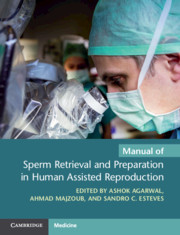Book contents
- Manual of Sperm Retrieval and Preparation in Human Assisted Reproduction
- Cambridge Laboratory Manuals in Assisted Reproductive Technology
- Manual of Sperm Retrieval and Preparation in Human Assisted Reproduction
- Copyright page
- Dedication
- Contents
- Contributors
- Editor Biographies
- Preface
- Part I Introduction
- Part II Sperm Retrieval
- Part III Laboratory Handling of Retrieved Sperm
- Chapter 11 Critical Factors for Optimizing Sperm Handling and ICSI Outcomes
- Chapter 12 Sperm Cryopreservation
- Chapter 13 Future Directives in Sperm Handling for ART
- Index
- References
Chapter 11 - Critical Factors for Optimizing Sperm Handling and ICSI Outcomes
from Part III - Laboratory Handling of Retrieved Sperm
Published online by Cambridge University Press: 09 April 2021
- Manual of Sperm Retrieval and Preparation in Human Assisted Reproduction
- Cambridge Laboratory Manuals in Assisted Reproductive Technology
- Manual of Sperm Retrieval and Preparation in Human Assisted Reproduction
- Copyright page
- Dedication
- Contents
- Contributors
- Editor Biographies
- Preface
- Part I Introduction
- Part II Sperm Retrieval
- Part III Laboratory Handling of Retrieved Sperm
- Chapter 11 Critical Factors for Optimizing Sperm Handling and ICSI Outcomes
- Chapter 12 Sperm Cryopreservation
- Chapter 13 Future Directives in Sperm Handling for ART
- Index
- References
Summary
This chapter covers topics including: (1) timing of sperm retrieval, particularly whether or not it should be performed in conjunction with oocyte retrieval from the female partner; (2) processing of surgically retrieved sperm for intracytoplasmic sperm injection (ICSI) –which are the most appropriate types of sperm preparation techniques in cases of epidydimal- or testicular-retrieved spermatozoa, and low or high numbers of retrieved spermatozoa; (3) selection of surgically retrieved sperm for ICSI, including methods for the selection of immotile spermatozoa, if needed, such as mechanical touch technique, hypoosmotic swelling test, chemical motility enhancers (e.g., pentoxifylline and theophylline), laser-assisted immotile sperm selection, and birefringence–polarization microscopy; (4) artificial oocyte activation, which may be useful in those selected patients who might have low fertilization potential, as well as the potential benefits of mechanical activation, electrical stimulation, and chemical activation on ICSI outcomes.
Keywords
- Type
- Chapter
- Information
- Publisher: Cambridge University PressPrint publication year: 2021

